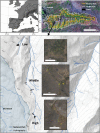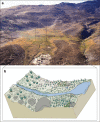Dataset of Phenology of Mediterranean high-mountain meadows flora (Sierra Nevada, Spain)
- PMID: 25878552
- PMCID: PMC4391960
- DOI: 10.3897/phytokeys.46.9116
Dataset of Phenology of Mediterranean high-mountain meadows flora (Sierra Nevada, Spain)
Abstract
Sierra Nevada mountain range (southern Spain) hosts a high number of endemic plant species, being one of the most important biodiversity hotspots in the Mediterranean basin. The high-mountain meadow ecosystems (borreguiles) harbour a large number of endemic and threatened plant species. In this data paper, we describe a dataset of the flora inhabiting this threatened ecosystem in this Mediterranean mountain. The dataset includes occurrence data for flora collected in those ecosystems in two periods: 1988-1990 and 2009-2013. A total of 11002 records of occurrences belonging to 19 orders, 28 families 52 genera were collected. 73 taxa were recorded with 29 threatened taxa. We also included data of cover-abundance and phenology attributes for the records. The dataset is included in the Sierra Nevada Global-Change Observatory (OBSNEV), a long-term research project designed to compile socio-ecological information on the major ecosystem types in order to identify the impacts of global change in this area.
Keywords: Sierra Nevada (Spain); Wet high-mountain meadows; abundance; global change monitoring; long-term research; observation; occurrence; phenology.
Figures





Similar articles
-
Dataset of Passerine bird communities in a Mediterranean high mountain (Sierra Nevada, Spain).Zookeys. 2016 Jan 13;(552):137-54. doi: 10.3897/zookeys.552.6934. eCollection 2016. Zookeys. 2016. PMID: 26865820 Free PMC article.
-
Sinfonevada: Dataset of Floristic diversity in Sierra Nevada forests (SE Spain).PhytoKeys. 2014 Feb 17;(35):1-15. doi: 10.3897/phytokeys.35.6363. eCollection 2014. PhytoKeys. 2014. PMID: 24843285 Free PMC article.
-
FloraSNevada: a trait database of the vascular flora of Sierra Nevada, southeast Spain.Ecology. 2020 Sep;101(9):e03091. doi: 10.1002/ecy.3091. Epub 2020 Jul 23. Ecology. 2020. PMID: 32365220
-
Effects of Livestock Grazing On The Ecology Of Sierra Meadows: A Review of The Current State of Scientific Knowledge To Inform Meadow Restoration And Management.Environ Manage. 2022 Jun;69(6):1118-1136. doi: 10.1007/s00267-022-01634-7. Epub 2022 Mar 29. Environ Manage. 2022. PMID: 35352198
-
How does climate change affect regeneration of Mediterranean high-mountain plants? An integration and synthesis of current knowledge.Plant Biol (Stuttg). 2018 Jan;20 Suppl 1:50-62. doi: 10.1111/plb.12643. Epub 2017 Nov 24. Plant Biol (Stuttg). 2018. PMID: 28985449 Review.
Cited by
-
Alpine bogs of southern Spain show human-induced environmental change superimposed on long-term natural variations.Sci Rep. 2017 Aug 7;7(1):7439. doi: 10.1038/s41598-017-07854-w. Sci Rep. 2017. PMID: 28785039 Free PMC article.
-
Local reports of climate change impacts in Sierra Nevada, Spain: sociodemographic and geographical patterns.Reg Environ Change. 2023;23(1):14. doi: 10.1007/s10113-022-01981-5. Epub 2022 Dec 16. Reg Environ Change. 2023. PMID: 36540304 Free PMC article.
-
The indigenous vascular flora of the forest domain of Anela (Sardinia, Italy).PhytoKeys. 2018 Dec 11;(113):97-143. doi: 10.3897/phytokeys.113.28681. eCollection 2018. PhytoKeys. 2018. PMID: 30584395 Free PMC article.
References
-
- APMM (Asociación Pastores por el Monte Mediterráneo) (2013) Ganadería Extensiva y PAC en Andalucía. Un análisis con propuestas para el futuro. Asociación Pastores por el Monte Mediterráneo and European Forum on Nature Conservation and Pastoral; http://www.pastoresmonte.org/dl94
-
- Aspizua R, Bonet FJ, Zamora R, Sánchez FJ, Cano-Manuel FJ, Henares I. (2010) El observatorio de cambio global de Sierra Nevada: hacia la gestión adaptativa de los espacios naturales. Ecosistemas 19(2): 56–68 http://www.revistaecosistemas.net/index.php/ecosistemas/article/view/46
-
- Aspizua R, Barea-Azcón JM, Bonet FJ, Pérez-Luque AJ, Zamora R. (Eds) (2012) Observatorio de Cambio Global Sierra Nevada: metodologías de seguimiento. Consejería de Medio Ambiente, Junta de Andalucía, 1–112.
-
- Aspizua R, Barea-Azcón JM, Bonet FJ, Pérez-Luque AJ, Zamora RJ. (2014) Sierra Nevada Global-Change Observatory. Monitoring methodologies. Consejería de Medio Ambiente, Junta de Andalucía, 112 pp http://refbase.iecolab.es/files/aspizua/2014/2714_Aspizua_etal2014.pdf
-
- Bartolomé C, Álvarez-Jiménez J, Vaquero J, Costa M, Casermeiro MA, Giraldo J, Zamora J. (2005) Los tipos de hábitats de interés comunitario de España. Ministerio de Medio Ambiente, Madrid, 1–287.
LinkOut - more resources
Full Text Sources
Other Literature Sources
